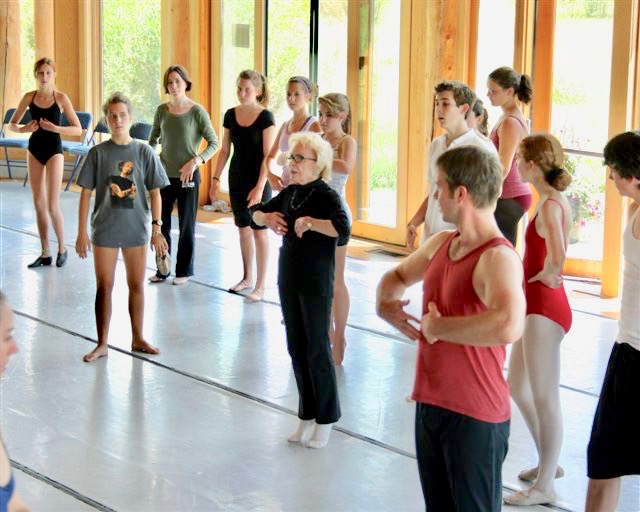One of the challenges that Linda Kent faced when she was Director of Dance at Perry-Mansfield was to provide really meaningful experiences for the dance students after their concert which was held the fourth week of camp. That meant there were still two weeks left of the six-week program. She came up with the idea of bringing guest artists to P-M so the students would be exposed to both master classes and a lecture demonstration by an outstanding artist.
In 2007, P-M faculty member Christina Paolucci arranged an amazing experience featuring Gemze de Lappe sharing work of Agnes de Mille, along with two dancers and a musician. (At that time I did not know about Agnes de Mille’s history with P-M. Check out Part I of this blog to learn about it.) I was thrilled that the students would be able to have master classes and a lecture demonstration, and so Murray and I made a contribution to P-M to help fund it.
Christina at the time was Educational Director/Associate Artistic Director at New York Theatre Ballet, and Gemze had been working extensively with NYTB from 2005 until her death in 2017 as NYTB presented many excerpts from de Mille’s ballets. A highlight of NYTB’s work on de Mille was a production called Dance/Speak. A description in TheatreMania describes it well:
The New York Theatre Ballet celebrates its 30th Anniversary season with the World Premiere of Dance/Speak: The Life of Agnes de Mille, a dance/drama which tells the story of choreographer Agnes de Mille’s struggle for success in the American theatre. Written by Anderson Ferrell, novelist and director of The de Mille Working Group; Directed by Scott Alan Evans; Staged by Gemze de Lappe (including dances from Oklahoma!, Carousel, Brigadoon as well as Fall River Legend, Three Virgins and a Devil, Rodeo, and Debut at the Opera) with Additional Choreography by Liza Gennaro. All performances are followed by an intimate panel discussion with the creators.
https://www.theatermania.com/shows/new-york-city-theater/dancespeak-the-life-of-agnes-de-mille_154271


An obituary in The New York Times helped me understand better the contribution that Gemze made to the dance world and to keeping the integrity of de Mille’s choreography. Richard Sandomer described it well in this quote:
Miss de Lappe understood that de Mille’s dancers had to be actors, and that her choreography — which was celebrated for incorporating elements of folk dancing and classical ballet — was as much about forging character as it was about learning the steps. When she recreated de Mille’s choreography, Miss de Lappe used her mentor’s vocabulary, vivid with motivational similes, to inform even the subtlest of movements.
The obituary also pointed out:
Miss de Lappe’s association with de Mille began in 1943 when she was cast in a small part in the first national tour of Rodgers and Hammerstein’s“Oklahoma!”
…“She was the potter’s clay for Agnes and one of her foremost interpreters,” Anderson Ferrell, director of the de Mille Working Group, which licenses performances of de Mille’s dances, said in a telephone interview. “Gemze was her muse.”
Here’s the link to read the full Obituary: https://www.nytimes.com/2017/11/17/obituaries/gemze-de-lappe-95-dies-keeper-of-the-agnes-de-mille-flame.html
Over the course of three days Gemze along with dancers Terence Duncan and Julie-Anne Taylor and music director Ferdy Tumakaka conducted a Repertory class for P-M dancers, held two master classes open to the public and presented an hour-long lecture demonstration. Repertory from Carousel, Brigadoon and Oklahoma were introduced. Christina and Terence remember that Gemze’s master class focused on the breath and very detailed characterization from Carousel.

Five years later in 2013, to celebrate the 100th anniversary of Perry-Mansfield Linda Kent turned to de Mille’s Rodeo and shared the following with me:
I wanted to celebrate our history and our dance present and future. Rodeo seemed the most perfect look back. I had great ambition and very little budget!!! Paul Sutherland and the de Mille estate worked with us and we did an excerpt of the second half of the dance. Paul has been the exclusive restager of Rodeo since 1979 and he gives the dancers so much more than steps!! It was a miracle to see contemporary 16-21 year olds ransformed into the gals and cowboys of de Mille’s first encounters. Our cowgirl, Cleo Person, was a delight in her awkward mooning over Keil Weiler as our Champion Roper (and fantastic tap dancer). Paul Sutherland was delighted and I was thrilled that we could bring this back to the community where the inspiration began.
Murray and I had already moved from Steamboat Springs to Santa Fe in late 2009 and while at first we returned in the summers, by 2013 we were busy sharing our artwork at fairs and didn’t make it up to Perry-Mansfield for the celebration. We did hear raves from our friends about how well the evening of dance went.
One of the most delightful things of writing the blog posts for Mostly Dance is the interaction I get with other artists sharing memories. I am very grateful to Linda Kent, Christina Paolucci and Terence Duncan for going through notes, photos and memories that made this post possible.
[print_link]


